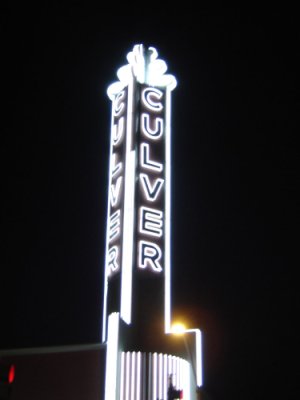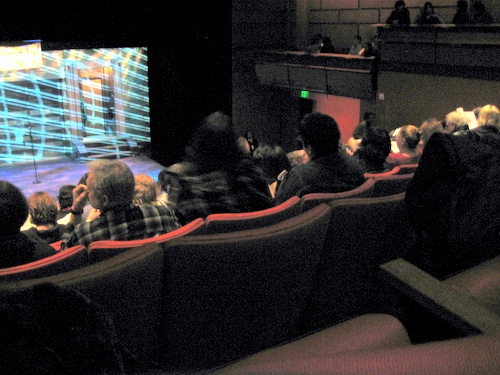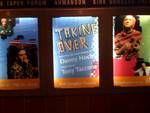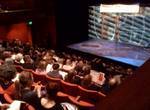
photo by Cindylu
Welcome to Part Two of the Taking Over reviews. A couple of reviews are still making their way through the LA Eastside digital transport, so please revisit this post in the next few days. (New review from Pachuco 3000 below!)
Part one can be found here.
Cindylu:
I’ve lived just a few minutes away from Downtown Culver City since 2000 in Palms South Robertson*. Despite living here for 8+ years, I only recently started spending any significant time (and money) in the area. Previously, there was nothing to do after 5 pm and a dearth of any other sorts of entertainment.
That’s all slowly been changing. The Kirk Douglas Theater playbill featured an article about the “revitalization” (aka gentrification) of DCC in recent years. In a small area you can find several architecture firms, art galleries, a couple of theaters, and several restaurants. On Tuesdays, local growers set up a farmer’s market on a 1-block long Main Street. If you go during a weekend night, you’ll find the 5 or so blocks between the Trader Joe’s and Kirk Douglas Theater quite busy. Now, I regularly shop at Trader Joe’s, buy fruit and vegetables at the farmer’s market, watch movies at the Pacific Theater and eat at some of the restaurants. I’d never gone to a production at the Kirk Douglas until last week. And yes, I can see the inherent contradiction of watching a play on gentrification in my neighborhood due to the gentrification in the area.
Back to the play. I first heard of Danny Hoch through Kris Diaz, a friend and dramaturg who has participated in Hoch’s Hip Hop Theater Festival. When I asked Kris if it mattered if I sat in the cheaper seats at the back of the theater or up close, he insisted that I sit up close. Kris also set me up with high expectations for the one-man play:
So maybe I’m a little biased, but I think that his new play Taking Over is one of the best pieces of theater I have ever seen. It does exactly what great hip-hop theater should be doing in this day and age: combining worlds, making disparate ideas and styles and cultures meet to form something new and powerful. It’s personal and it’s political. It’s hilarious and completely serious. It’s a relatively even-handed study of gentrification that still manages to take a strong point of view and stick to it wholeheartedly. I love this play. You need to go see it.
I followed Kris’ recommendation and was not let down. Unlike, Browne and Chimatli, I caught an matinee show with my boyfriend. However, the audience seemed a little too, um, old for the subject matter and Hoch’s style. I caught an elderly white man a few rows behind me nodding off. Although the boyfriend and I were not the only young people in the crowd, we seemed to be part of the very small people of color contingent judging by our reactions to the more polemical charactes. While the audience seemed to love Marion, the middle-aged woman who loved her almond croissants, they were silent during Robert and Launch Missiles Criticals’ rants.
My favorite characters were Kiko, an ex-con, trying to do right and the Dominican dispatcher. Kiko and the dispatcher were the only characters speaking one-on-one with the gentrifiers. They showed a different impact of the gentrification aside from feeling like a tourist or feeling invisible. Kiko and the dispatcher showed a deeper level to the indignity and pain felt in the inherent contradiction between men trying to make a living in the now gentrified Williamsburg. They literally have to lower themselves to drunken hipsters and lowly PAs unwilling to lend a hand. What struck me more was how a Variety reviewer could get the interaction between Kiko and the PA so wrong.
As for criticism, I wish Hoch would have read an appreciative letter from someone who lived in Williamsburg 20 years ago and was pushed out. Yes, I know we heard an amalgamation of their voices throughout the play. However, I don’t need to hear more from the hipsters. I hear enough from them. I want to hear from the people of color and those who do get it. I know those writers are out there.
* I was set straight by the LA Times’ mapping project.
…..
EL CHAVO!

Secret hidden forbidden pic!
I’m not a good reviewer of theater. I’m not even adequate. But for what it’s worth, as a person interested in the central themes that he dealt with, I”ll share some thoughts on this Taking Over play.
* Though the gentrification effects are happening in many places, it still seemed odd to be heading to Culver City for a snapshot on this reality. Maybe it should have been staged somewhere near some current areas of contention? Besides, I only go to Culver City for brewing supplies. Feel free to any assumptions.
* $20 for the cheap seats. Yes, I understand artists have to make a living. But I don’t understand why an important message has to be restricted from those that can most appreciate it. People with money, they love to delve into the lives of everyone, haves and have-nots. People without, they rarely get a chance to explore the very concepts that are all around them, and all about them.
* I insisted we eat before the long show. Nearby was a Mexican restaurant called Mrs. Garcia’s, where the veggie burritos are incredibly bland and the salsas are unnecessarily watery. During the play DH mentioned toned down ethnic foods as a part of gentrification, and I just had to laugh. Jaja!
* Browne mentioned how the performance of the performance was also a performance. Like being aware of another dimension that others have the good fortune never to have to think about. Of course, with a lifetime of being other, I can see it.
* Oh, check this out, there doesn’t seem to be much diversity in this crowd, both in terms of race or class. Maybe that shouldn’t matter yet, I’m mentioning it. Don’t ask me how I made this assessment, I must have class-dar.
* The performance starts out strong, with a character calling people out during some community building event, or at least holding them accountable for the changing neighborhood. It’s a bit of gut rage, and not too far-fetched from my point of view.
*The central theme is basically the emotional reaction to how some people experience their changing neighborhood, or how they see themselves in a new neighborhood. Danny Hoch is obviously taking sides with the long time residents, and is critical of the newcomers and the maybe unintended consequences of their arrival. At least it’s not some “let’s also talk about the good things of gentrification” bullshit, so he gets some points for that.
*One of my favorite characters was the local guy that just got out of prison and returned to a changed neighborhood. He was doing his best to understand things, and to communicate with the film crew that was shooting a movie in front of his house, but they obviously just saw him as a nuisance. I even liked the cautiously slinking stance, wavering forward and back as he tries to strike up a conversation and to ask for some sort of job, any job. Every neighborhood has that confident guy that never left (at least not by choice!) and defines his world basically by a few city blocks. They know everything about their area, but outside of it they are total unknowns. I thought this tentative breaching of the geographical and social lines of demarcation was done very well.
*It seemed like the audience had an odd criteria for what they thought was funny, laughing at what I thought were inappropriate moments, and seeming to get ruffled by some stuff that maybe hit too close to home. In any case, we found ourselves laughing alone at some stuff, so I guess it’s even.
*I wish he would have delved more into some of the examples of how gentrification works across class lines, and to also hold accountable people of color that contribute to gentrification. It seems that most people, on both sides of the equation, tend to associate gentrification with race, which despite the correlations, it’s just too easy and doesn’t really get to the base of the problem.
*The letters from audience members was quite hilarious, especially since many of those, as Chimatli mentions, sound like comments that have been left before on this blog.
* The success of this play shows that people do want to hear about these issues. Now we just need some competent Angelenos to explain the situation as it exits here, cuz I didn’t get lots of the New York references. Oh Well.
But yeah, it was an interesting outing.
…..

Pachuco 3000
I saw Danny Hoch’s “Jails, Hospitals & Hip Hop” back in 1997 and was totally impressed. He left a great memory of a great performer with a keen ear for voices and dialects. Something I like to do when I travel is to pick up on the accents and cadences of people, Hoch is a master at this.
Walking up to the theatre I ran into Richard Montoya of Culture Clash who also have done great work capturing moments in a localized area with their works: “Radio Mambo: Culture Clash Invades Miami,” and “Bordertown.” Like Hoch, Culture Clash got the characters, accents and flow of the residents of their chosen locales.
Many people and reviews pumped up this show and being a Hoch fan I was ready to be impressed, again.
The issue of gentrification has been a running theme in my life in general, so I was ready to hear his spin on it to gather some more verbal artillery in my debates and maybe some insights into what else may lay ahead in the near future.
“Taking Over” focused on the people on the victim side of gentrification. Kiko was one of my favorites because he is like my real friend Henry, supper humble and cautious around people he sees as having more than himself. When Kiko goes to calling a PA ‘sir’ to get his attention it struck a chord in me on how racial hierarchies are embedded in us and how easy some of us slip into the ‘si senor’ or ‘yes massa’ mode to gain favor. Another point that was verbalized by Kiko, and several other characters, was the issue of being invisible to the gentrifying hoards. One black female character says she was able to go into one of their bakeries and walk out with two almond croissants and no one even noticed.
The most impressive monologue was the Dominican taxi dispatcher. Within this Hoch played on Puerto Rican, Mexican and Dominican issues of assimilation, the American dream, language, and tensions. Calling his compatriots ‘hicks’ for not knowing the city or for being afraid of picking up drunk, gay, white clients was one side of this character who would later scold his son for speaking Spanish to him. He didn’t want his kid to be perceived as an immigrant. Deep if you know what I mean. I busted up on his play on the Mexican accent while scolding the cabby for supposedly selling tacos out of his cab.

Other impressive monologues for me were the French realtor, the Jewish developer and the white girl selling Mexican handbags on the street. Forgot their names, but that is of course not the point. The point is all of them see where they are as something to be changed into what they want or need. They don’t want to just be, they want to colonize. The French guy was already looking for the new lands to change, the developer had the plan (including free rent to desirable clients) to create ‘the real world’ where people are only happy when there is shopping to be had, and the white girl came for authenticity but loved the changes she was a part of more than the people already there.
The Williamsburg of “Taking Over” is much like our downtown LA. The development is at luxury condo level. In the Eastside, we are at the letting desirable businesses have free or cheap rents. We still aren’t hosting overpriced cafes, although we do have an overpriced bar.
My hope and my dream is that the Eastside and Los Angeles in general, like it has usually done, will break the mold of what the powers that be have in mind. Mother nature helps us with her earthquakes that shake off those with shallow roots. Our history that is in the air, smeared on the walls and runs invisible to non native eyes always raises its clenched fist of rebellion, or our open hand of “come in, we know you won’t last long.” We will outlive them. Out-last them by over populating them. Out-funk them and out they will go, to Portland most likely. We aren’t an island. Yes many have been pushed out to the Inland Empire, but I believe many will be back. Its like the waves on our coast, there are small waves, then there are big ones. Our numbers on one level and our roots in another cannot be ignored. WE won’t be ‘si senor’ -ing nor will we be invisible.
At the end Hoch summed it, “Stay home.” Although he can’t stay home because they don’t pay him in New York to tell New York stories, he knows that it really is better at home.
On one level it is an immigrant story as twisted as it may seem. Latinos leave their homes to get job opportunities. Midwestern kids migrate to leave right wing politics and religion or maybe just boredom. We can’t seem to stay home and fix our problems in our own homes. We pick up and leave and go somewhere else where we can be who want to be, not who we are. Sometimes we forget the difference, but now I’m getting into other things.

I think it’s interesting you mention not getting a lot of the New York references. I’m sure I missed many little jokes myself. I think there were some Nuyoricans in the crowd cause they busted out laughing at all kinds of stuff I didn’t get.
One thing I forgot to mention in my review was the constant references to the newcomers being from California. Like Californians represented the worst of the gentrifiers. I understand what he meant and I know what kinda Californians would move to Williamsburg, they are cousins to all the people from Brooklyn who have moved to Echo Park. They are the same people. Mirror images of each other. I’ve heard more than a few people exclaim how Echo Park is “Little Brooklyn” and how they run into old neighborhood people. I’m not as harsh as some of DH’s characters. New Yorkers are welcome to move here just don’t complain about our food, learn to love tacos, mofos! 😉
I admit, I grew up hating New Yorkers, it’s the one group my parents allowed me to hate! (They were progressive in every other way.) Everything wrong with Los Angeles was blamed on “New Yorkers” from rudeness to bad driving to density. How funny then, to watch this play with the blame being flipped. For the longest time, I could not bear to listen to those accents. They drove me crazy! I’m curious as to what the New York-Mexican accent will develop into now that Poblanos have started moving into the New York area.
If any of our readers saw the play, we invite you to leave your thoughts, comments and ideas here.
Also, if Danny Hoch or his publicity agent reads this, hook us up next time. We gave you all a lot of free press. 🙂
Chavo,
I’ve eaten at Mrs GarcÃa’s once. I don’t remember it being worthy of a second chance.
this is going to sound weird, but i participated in gentrifying both culver city and williamsburg. i worked at a website in cc in the late 90s, when the helms bakery and the area near the la ballona restaurant were being gentrified. what a trip. i didn’t even know it was changing.
second, i met someone at this job who eventually asked me to write for a small magazine in new york that someone she knew was publishing. so i tried to write a couple articles. they kind of sucked. anyway, the magazine covered williamsburg. (i did this from l.a.) until last year, i didn’t even know what williamsburg was.
the visible aspect of gentrification is the change in commercial spaces, where businesses serving a working class community are displaced by businesses serving a wealthier community.
the invisible aspects are things like work and media — often the same thing in my case.
baudrillard has this great line, “the map precedes the territory”. it’s true. the idea of “williamsburg”, established in the magazine, and its collection of advertisers, which included the gentrifier businesses and workplaces, but excluded the existing community, participated in the ongoing gentrification of williamsburg.
it’s a map of segregation… amidst actual multicultural conflict. eventually, real segregation follows.
i glanced through the thin zine, and assumed williamsburg was like north hollywood or west hollywood. you know – mostly white folks who work in media, if not in a creative capacity, then in doing construction and labor. (in a way, i guess it was like west hollywood. that place got colonized long ago.)
what did i know? i was just a fortunate computer nerd who got to write stuff. that job was what i’d call a typical internet gig. you just get the opportunity to work for someone far away, for some money, and it’s easy enough, so you do it. it’s very “globalized.”
i mean, that’s almost beyond gentrification.
it’s like, that “eastside” map that la eastide burned up. imagine if the cartography was outsourced to some person in canada or, heck, mexico. the companies involved in gentrification can use the global labor market to quickly bring together the labor to push into a neighborhood, and take it over, before the locals even have time to gather the people, capital, and political influence to fight back.
and these people assisting the take over may not even be aware of what they’re doing.
these were just jobs to me.
not only that, i was commuting from monterey park part of the time. internet jobs just don’t show up that much on the eastside.
El Chavo is a home brewer? We’ve got to hang out sometime. Sorry for the OT but why are eastside brewers so undercover?? What only hueros on the beach like beer?